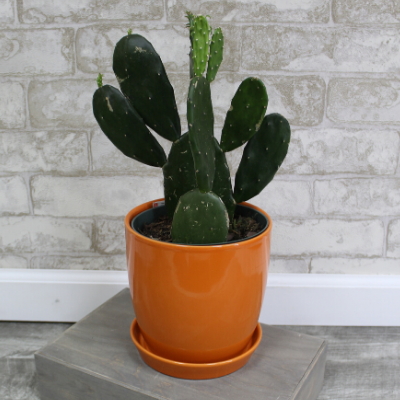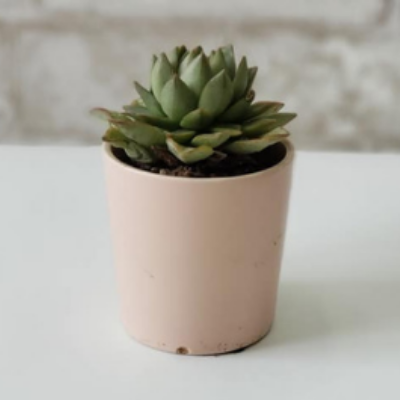Call Us Now! 800-335-4769
Top 10 Low-Maintenance House Plants

Green plants provide great benefits to indoor décor. They brighten a home or office, plus create healthy environments by cleaning the air and adding oxygen and humidity to a room. Shop a selection of our house plants online.
Just one 8 to 10-inch potted plant per 100 square feet of space can help increase health and well being. Caring for plants need not be a full-time job. Here’s our list of the top low- maintenance plants that thrive indoors.
Aglaonema
Aglaonemas are versatile plants that thrive in a variety of conditions making them great for new plant parents. The Spring Snow Aglaonema has white and green variegated leaves that look like it was sprinkled with fresh snow. These plants are available in a variety of sizes to fit any home or office.
Light: Aglaonmena prefers bright, indirect light, but will thrive in lower lighting conditions. You may notice the variation starting to fade though if they are in lower lit areas.
Water: These plants like to have moist soil and to dry out between waterings. It is best to let them dry out a bit rather than overwatering them, as this can cause root rot.
Fertilizer: Use a balanced house plant fertilizer diluted to half-strength every other month in the Spring and Summer. Do not apply fertilizer to dry soil, make sure fertilizer is damp before feeding your plant.
Aloe
Aloe Vera is a versatile house plant that is easy to care for. This succulent has fleshy leaves filled with a medicinal gel that is great on burns, cuts, and as a skincare product. They are easy to grow, and low-maintenance.
Light: Place your Aloe plant near a south-facing window or an area that gets bright, indirect light. Like other succulents, aloe will start to get leggy if not given enough light.
Water: Water every three weeks thoroughly, allowing the water to run through the bottom of the pot. Do not let your plant sit in water, Aloe prefers drier soil.
Fertilizer: Aloe plants don’t need to be fertilized. If you want to give them a little boost, use a phosphorous heavy fertilizer diluted to half strength once a year in the Spring.
Cacti
Cactus plants are the ultimate in low-maintenance. Available in many sizes, shapes and colors, these are perfect plants for the first-time plant parent.
Light: Cactus like lots of sun, but not direct sun-light. Keep them near a south-facing window, or outdoors in a bright spot away from direct sun. Your plant will become leggy (stretched out) if it isn’t getting proper light. Green succulents can tolerate lower lighting conditions than pinks, purples and whites.
Water: Water once a week, or when the soil dries out completely.
Fertilizer: Use a 5-10-10 fertilizer like, Miracle-Gro Succulent and Cactus Food, every 8 weeks during the Spring and Summer. Do not fertilize during the Winter and Fall, as cacti are in a semi-dormant state and do not need extra nutrients.
Peace Lily
Peace Lilies are low-maintenance plants great for beginners. These plants have dark green foliage and will sprout white spathes, or waxy flowers, in the Spring.
Light: These plants do great in low lighting conditions like offices, or hallways and can even grow with just fluorescent light. If given too much light, the leaves will start to turn yellow.
Water: Your Peace Lily needs water about once a week. The leaves will start to droop when it’s thirsty, letting you know it’s time for a drink.
Fertilizer: Use a well-balanced, water-soluble liquid house plant fertilizer on your Peace Lily every 6 weeks during the spring and summer to encourage growth.
Philodendron
Philodendrons are another popular house plant that is easy to care for. These plants have great indicators to let you know what they need.
Light: Philodendrons like bright, indirect light. They even do well with low or fluorescent lighting. If your plant gets leggy or has large gaps without leaves, it needs more light. If multiple leaves start yellowing, it means it’s getting too much light.
Water: These plants like to dry out between waterings. Allow the top few inches of soil to be dry before giving the plant a thorough drink. The leaves will start to droop if it needs a drink. They should perk back up quickly once watered.
Fertilizer: Use a liquid plant food 2 to 3 times a year to ensure your plant is getting the proper nutrients. Slow growth and small leaf size is a good indicator that you plant needs a food boost.
Pony Tail Palm
With their unique-looking bulbous trunk, stringy, curly leaves, and forgiving nature, they are great plants for any level of plant parent. It may look like a mini palm tree, but it is neither a palm nor a tree. Ponytail Palms are actually a variety of agave, giving them succulent-like characteristics.
Light: Ponytail Palms prefer bright, indirect light. Rotate your plant periodically so it grows evenly. Ponytail Palms are slow-growing, so don’t be alarmed if you don’t see much growth throughout the year.
Water: Allow your Ponytail Palm to dry out between waterings. They store water in their bulbous trunk making them drought tolerant. Be careful of over-watering. Check the soil every 2-3 weeks during the spring and summer and once a month during the winter. Only water when the soil is dry all the way through.
Fertilizer: Even though these plants are slow growers, giving them a nutritional boost once a month with a balanced house plant fertilizer will help keep them happy.
Pothos
Pothos Marble Queen is a popular trailing house plant that is practically indestructible. It is great at cleaning the air and has variegated leaves.
Light: Pothos can survive in low lighting conditions but does best with bright indirect light. Lower lighting conditions may cause your plant to lose its variegation.
Water: Water your pothos only when the soil is completely dry. These plants will start to droop when they need water. If the edges turn brown or they start to shrivel it means you need to water more often. Thoroughly soak the soil when it’s time to water.
Fertilize: Use a water-soluble fertilizer on your pothos 2 to 3 times a year to make sure it’s getting proper nutrients.
Sansevieria or Snake Plant
Snake Plant, Sansevieria or Mother-in-law’s Tongue, is another low-maintenance option for new or seasoned plant parents. Available in several varieties, Snake Plant is a must-have for any room of your home.
Light: Snake Plants aren’t fussy about where their light comes from. They will do great with bright, in-direct sunlight, or within dimly lit hallways or offices. Just keep your snake plant away from direct sun as the leaves can get scorched.
Water: Snake Plants can go a while between waterings, and prefer their soil to dry out. Watering regularly is great, but don’t overwater. It is best to underwater these plants to prevent the roots from getting waterlogged.
Fertilize: A general, all-purpose plant food can be used once a month on your snake plant during the growing season which is April to August.
Succulents
Succulents are a great low-maintenance option for people looking to add some greenery to their indoor space. These plants thrive on neglect and will do great if you forget about them for a few weeks (or months).
Light: Succulents love bright indirect sunlight. Place them in a well-lit location, but protect their leaves from direct sun, even through a window. They can get sunburned and will turn brown. Dark green succulents will need less light than purple, who are bit pickier.
Water: Water your succulent once a week. Although these plants can go a bit between waterings, the more regularly they are watered the better they will be.
Fertilizer: Succulents don’t need much food. You can use succulent plant food once a year to give them a boost.
ZZ Plant
ZZ plants are as low maintenance as they come. With long stems and glossy leaves, these plants will dress up any room, office, and or hallway.
Light: ZZ Plants will do great in any lighting condition and can even thrive in fluorescent lighting. Avoid direct sunlight, because the leaves can get sunburned.
Water: ZZ Plants like to dry out between watering, and can even thrive if forgotten for a bit. When in doubt underwater. Overwatering this plant can cause root issues, and stems to turn yellow. If plants are outside in the summer, try to keep away from an automatic sprinkling system where they could get too much water.
Fertilize: During the growing season (April to August), fertilize with a liquid fertilizer once a month.
Visit any English Gardens location and an expert can help you select a plant that’s perfect for your home or office.



















